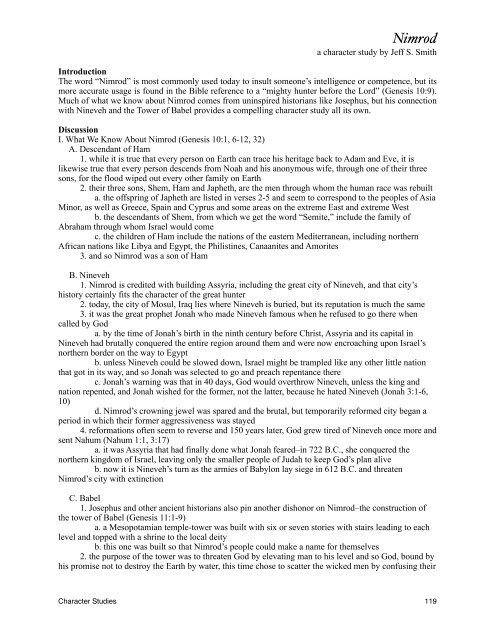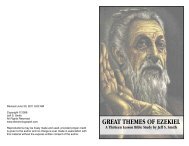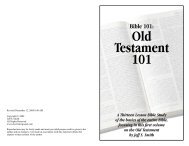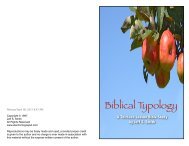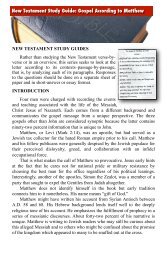Character Studies - ElectronicGospel
Character Studies - ElectronicGospel
Character Studies - ElectronicGospel
- No tags were found...
Create successful ePaper yourself
Turn your PDF publications into a flip-book with our unique Google optimized e-Paper software.
Nimroda character study by Jeff S. SmithIntroductionThe word “Nimrod” is most commonly used today to insult someone’s intelligence or competence, but itsmore accurate usage is found in the Bible reference to a “mighty hunter before the Lord” (Genesis 10:9).Much of what we know about Nimrod comes from uninspired historians like Josephus, but his connectionwith Nineveh and the Tower of Babel provides a compelling character study all its own.DiscussionI. What We Know About Nimrod (Genesis 10:1, 6-12, 32)A. Descendant of Ham1. while it is true that every person on Earth can trace his heritage back to Adam and Eve, it islikewise true that every person descends from Noah and his anonymous wife, through one of their threesons, for the flood wiped out every other family on Earth2. their three sons, Shem, Ham and Japheth, are the men through whom the human race was rebuilta. the offspring of Japheth are listed in verses 2-5 and seem to correspond to the peoples of AsiaMinor, as well as Greece, Spain and Cyprus and some areas on the extreme East and extreme Westb. the descendants of Shem, from which we get the word “Semite,” include the family ofAbraham through whom Israel would comec. the children of Ham include the nations of the eastern Mediterranean, including northernAfrican nations like Libya and Egypt, the Philistines, Canaanites and Amorites3. and so Nimrod was a son of HamB. Nineveh1. Nimrod is credited with building Assyria, including the great city of Nineveh, and that city’shistory certainly fits the character of the great hunter2. today, the city of Mosul, Iraq lies where Nineveh is buried, but its reputation is much the same3. it was the great prophet Jonah who made Nineveh famous when he refused to go there whencalled by Goda. by the time of Jonah’s birth in the ninth century before Christ, Assyria and its capital inNineveh had brutally conquered the entire region around them and were now encroaching upon Israel’snorthern border on the way to Egyptb. unless Nineveh could be slowed down, Israel might be trampled like any other little nationthat got in its way, and so Jonah was selected to go and preach repentance therec. Jonah’s warning was that in 40 days, God would overthrow Nineveh, unless the king andnation repented, and Jonah wished for the former, not the latter, because he hated Nineveh (Jonah 3:1-6,10)d. Nimrod’s crowning jewel was spared and the brutal, but temporarily reformed city began aperiod in which their former aggressiveness was stayed4. reformations often seem to reverse and 150 years later, God grew tired of Nineveh once more andsent Nahum (Nahum 1:1, 3:17)a. it was Assyria that had finally done what Jonah feared–in 722 B.C., she conquered thenorthern kingdom of Israel, leaving only the smaller people of Judah to keep God’s plan aliveb. now it is Nineveh’s turn as the armies of Babylon lay siege in 612 B.C. and threatenNimrod’s city with extinctionC. Babel1. Josephus and other ancient historians also pin another dishonor on Nimrod–the construction ofthe tower of Babel (Genesis 11:1-9)a. a Mesopotamian temple-tower was built with six or seven stories with stairs leading to eachlevel and topped with a shrine to the local deityb. this one was built so that Nimrod’s people could make a name for themselves2. the purpose of the tower was to threaten God by elevating man to his level and so God, bound byhis promise not to destroy the Earth by water, this time chose to scatter the wicked men by confusing their<strong>Character</strong> <strong>Studies</strong>! 119


